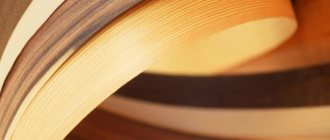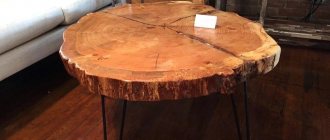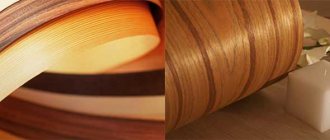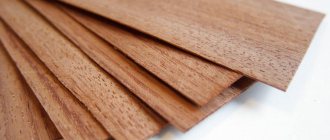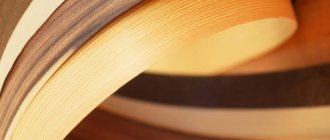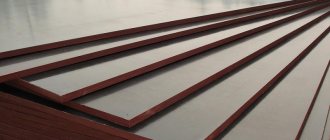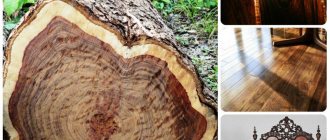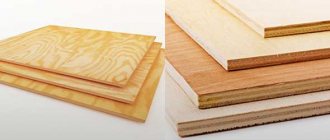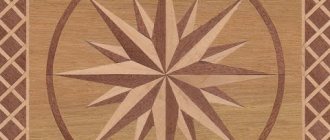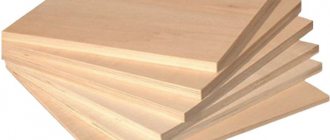The desire of consumers to have furniture, interior and interior structures made of natural wood is not always feasible due to the high cost of natural material. There is no point in especially regretting this, because products made from solid wood have a lot of weight, and, moreover, over time they can dry out and become deformed. In this regard, veneer is often used for finishing.
Products made from natural veneer are very similar in appearance to solid wood, while the products cost much less and can be used without problems.
What is veneer called?
Veneer is a word of German origin meaning wood chips. Apparently, at the time the term was borrowed, they were synonymous. Nowadays, wood chips mean chopped wood. There are several types of wood chips, the best of which are called technological. After additional chemical treatment, some of them are used in the production of boards from wood fibers and chips.
All modern types of veneer are obtained by more subtle mechanical methods of wood processing, for which special technological equipment is used. As a result, plates of small thickness and relatively large (for crushed raw materials) surface area are formed. They don't look like wood chips at all.
The advantages of veneered products are as follows:
- the coating has a beautiful pattern, which is further enhanced during processing;
- veneer of exotic species can be used to decorate a base made of inexpensive wood;
- in case of minor damage, the appearance of the surface can be easily corrected by minor repairs;
- veneer allows you to restore old structures and products without large financial costs;
- a thin layer of coating allows you to carry out the work yourself using ordinary tools.
When working with solid natural wood, you have to make a lot of physical effort, use woodworking machines and special tools, but working with veneer is much easier.
Acceptance of sliced veneer
The cost of sliced veneer depends on the slot of timber, the size of the wedge, and the number of flaws. Acceptance of veneer is carried out by a specially trained qualified acceptor. For testing, three sheets of veneer are taken from the packs: top, middle and bottom. Experts determine the following parameters:
- appearance
- dimensions
- humidity level
- roughness
- waviness.
Appearance is determined visually. Material deficiencies are measured according to GOST 2140.
To determine the thickness, it is necessary to measure at three points, evenly located along the length of the sheet at a distance of at least 25 mm from the edges, with a device called a thickness gauge. The length and width of the veneer is measured at the midpoint of the width and length of the sheet using a metal ruler or other measuring device.
The slant of the sheet is determined using a square, which is applied to the adjacent edges of the sheet, and the most significant deviation of the edge of the sheet from the edge of the square should be measured with a ruler.
To determine roughness and moisture level, there are also certain GOST documents.
Wood cutting methods
Veneer panels can be removed from semi-finished wood products in several ways. Their choice is determined by the type of raw material, its condition, the direction of future use of the product, and the equipment of the manufacturer.
The main types of mechanical actions are as follows:
- planing;
- peeling;
- Sawing
Each procedure requires special equipment, the use of wood of the required quality, and the degree of its preparation. Finished veneer differs in aesthetic features, respectively, in its usability and price.
Planed material
Planing produces veneer of oak, mahogany, ash, beech and two main conifers: pine and larch. The products have a beautiful texture and are used primarily as a facing material. For the production process, sawn beams or so-called vanches are taken, which, after steam treatment, are cut on special planing machines.
Note! Planing can be carried out in different directions, resulting in different patterns on the plates.
After radial planing of the veneer, carried out strictly along the end, a pattern of parallel rings is formed on it, located evenly over the entire surface. Radial veneer made in this way is designated by the letter R.
Due to half-radial planing, the pattern of rings occupies approximately ¾ of the area of the resulting layer. The veneer obtained as a result of such a mechanical action is designated by the letter combination PR.
As a result of tangential processing, the rings have the appearance of curved strips. The plates obtained by planing along a tangent (tangent to the annual ring) are designated by the letter T. Sometimes the name “tangential” is found. It cannot be called incorrect, since masters often use such a term.
After tangential-end planing, the pattern is formed by looped oval curved lines, on which dashed core rays are visible. The type of such veneer, formed as a result of planing technology along the axis between the end and the tangential plane, is designated by the letter combination TT.
Types and thickness of sliced veneer
According to the quality of wood and the thoroughness of processing, planed products are divided into two grades. Types of natural veneer from group 1 have minimal defects in the form of spotting, internal sapwood, dark growth, cracks, scratches or do not contain them at all. Types of veneer from the 2nd grade group are controlled much more loyally, because the standard allows for the presence of defects in products.
The thickness of wood plates varies from 0.5 to 1 mm. Veneer obtained by tangential, full or half radial cutting has a length reaching 900 mm and a width reaching 120 mm. Products with the TT designation are usually smaller in size. The permissible surface roughness indicator varies. For oak, mahogany, ash, pine, larch it is 200 microns, for other wood - 100 microns.
All veneer produced by planing is dried until a moisture content of 8% is reached and then packaged.
Peeled veneer
Ribbon-like veneer is called peeled veneer. It is removed from the surface of the wood using a special machine. Long strips are dried, cut into pieces of specified sizes and used as a semi-finished product for the production of plywood, multilayer panels, glued elements of building structures, cladding, and food packaging.
The outer coverings that rotary cut veneer creates look a little worse than those made from planed pieces. The advantage of this type is the larger surface area of the plates. It is not always advisable to process valuable wood species by peeling, but a semi-finished product from common raw materials, such as poplar, after veneering turns into a sought-after product.
The length of each product varies from 800 to 3750 mm. The width varies from 150 to 3750 mm, the pitch in the line varies from 50 mm to 100 mm. Requirements for thickness indicators depend on the type of wood. For thin plates made of hardwood, the maximum is 4 mm, for thicker ones 6.5 mm.
Veneer is divided into 5 grades: elite and others, including from 1st to 4th grade. Next to the digital designation of the grade of coniferous wood products there is the letter X.
The moisture content of the finished veneer should not exceed 6%, the roughness index for hardwood products cannot exceed 200 microns, and for coniferous products - 320 microns.
Sawn veneer
Man learned to saw wood into layers a long time ago. Making thin sheets using a saw, even the most modern form, is difficult, and the process is accompanied by a large amount of waste. Lamels made by sawing have a thickness from 1 to 12 mm.
Note! Sawn veneer is used for inlaying expensive furniture and decorative interior elements.
The peculiarity of sawn veneer is that it can be selected according to the pattern of the main part of the wood of the product. The result will be very beautiful and impressive, but you will have to pay a lot of money for it. Sheet veneer, sawn from cedar, spruce, and fir wood, is often used to form bent design elements for furniture or stairs. The products are used individually or in combination with MDF material.
In some sources you can see information about the use of sawn veneers for finishing musical instruments. The content of the state standard indicates that peeled or planed veneer plates are used for these purposes. Thus, for rough veneering of pianos, types obtained by peeling hardwood are used; for finishing veneering, planed pieces of veneer of ash, pear, walnut or American walnut, maple, elm, oak and even mahogany (for the most expensive instruments) are used.
Production of sliced veneer
For work, only absolutely straight, flawless trunks are selected, which are distinguished by the correct arrangement of fibers and the shade typical for each type of timber. Before processing on a planing device, an even rectangular beam is made from the selected tree trunk. The width of the beam will be equal to the width of the finished material; accordingly, the larger the width of the workpiece, the larger the area of the final sheet. Since the veneer strips are quite narrow, they must be glued using special adhesives or stitched.
The latest technologies make it possible to ensure high-quality joining of individual parts without visible joints into large-format sheets. Large sheets are created from strips from the same batch to provide uniform color and a smooth, attractive texture.
Planing machines can contain two types of knives:
- straight
- wavy.
The most popular are straight cutting knives, which allow you to obtain smooth material with a thickness of 0.1 to 1.4 mm. By using wavy knives, wavy veneer is obtained, which is characterized by a fairly high decorative value. A similar material is used for finishing designer furniture and producing interior finishing panels. Smooth sheets are used more widely; they can be used in the manufacture of furniture facades, interior doors, and cladding parts for residential and office rooms. By changing the cutting angle, sheets with a unique texture can be obtained. Many experts consider sliced veneer to be the best option for furniture finishing.
However, high-quality planed sheets are not obtained from all types of timber. Deciduous varieties, such as birch, hornbeam, beech, walnut, and aspen, are best suited for this work. In addition, sliced veneer is produced from valuable exotic varieties, such as mahogany. Coniferous timber is much less popular. Due to the fact that the finished product is completely natural, it fully retains the characteristics of solid wood, including resistance to biological and climatic effects.
Modern production technologies
In addition to traditional methods, many enterprises have introduced and are successfully using new approaches to the production of veneer products.
Variegated, multi-character multi-veneer is popular, the surface of which may have light or dark brown shades, gray tones with different textures. There are design works that create a strictly defined or chaotic pattern, unlike natural colors, but with the texture of wood. The products are in demand among connoisseurs of non-standard solutions in interior design.
How to choose furniture veneer
Furniture made from natural wood is available to a limited number of consumers due to its high cost. But there is a wonderful alternative: furniture veneer - a material that is used for decoration. They not only cover the surface of products, but also inlay them. The appearance of such pieces of furniture is not inferior to expensive, exclusive models made from valuable wood. With the help of designer veneer you can create a magnificent composition that will decorate any interior. The different colors and textures of this natural wood material, harmoniously selected and combined with each other, will add charm and comfort to the room.
When choosing veneer for making custom-made furniture, the consumer is guided by his own taste, as well as the purpose of the room for which the furniture is required.
Fine-line features
Products with a unique name, understandable to anyone who studied English at school, indeed have beautiful lines on the surface. The material is made from wood waste, as a result of which its cost is more affordable than that of first-class natural veneer. This type of veneer is also called reconstructed. Fine-line products are presented in an assortment, have a wide range of colors, and can easily undergo further processing.
The technological cycle for the production of reconstructed veneer includes the following stages:
- removal of plates on peeling machines;
- drying and sorting;
- impregnation with dye in containers;
- treatment with adhesives;
- pressing;
- formatting by planing.
Thus, the products are peeled and at the same time planed. The moisture content of the material should be in the range from 8 to 12%. The types of reconstructed fine-line plates with a thickness of 0.35...5 mm and a density of 450 to 600 kg/m3 are in greatest demand. The final product contains up to 94% natural wood, approximately 6% adhesive, and no more than 2% color pigments.
Fine-line coatings can imitate the texture of any wood species and create textile patterns, such as a satin surface pattern. Fine-line veneer has great plasticity and heat resistance, does not react to humid air conditions, and is easily varnished.
Kinds
Sliced veneer, in accordance with GOST, is divided into types according to wood texture. It depends on the location of the workpiece in the machine, or more precisely, the trajectory of the knife relative to the core of the log.
Accordingly, veneer can be:
- Radial (marked P) - annual layers on a plane look like almost straight lines filling the entire sheet. The medullary rays also form stripes that occupy 3/4 of the leaf or more.
- Semi-radial (SR) - annual layers form parallel lines occupying at least 3/4 of the leaf. The medullary rays look like longitudinal or oblique stripes, filling half the leaf.
- Tangential (T) - layers form curved lines, angles and cones (the same U and V-shaped pattern). The rays form longitudinal or oblique lines and strokes.
- Tangential-end (TT) - layers form closed curves, rays - curved lines or strokes.
Products made from certain types of wood, due to the implicit design, are not divided into types. For example, from walnut, pear and mahogany. Pine veneer is divided exclusively into radial and semi-radial.
Interior doors made of veneered MDF
MDF and veneer are those materials that, due to their properties, have become the most successful option for replacing natural wood, and when they are combined, objects are obtained of excellent quality and are not inferior to the natural prototype.
In order to produce veneered MDF doors, a special technology using high pressure and temperature is used. It is this that ensures such properties of the material as reliability, practicality and durability. Due to the very high compaction density, such doors are moisture resistant and practically do not deform. Compared to wooden models, they are more functional. Their advantages: light weight, aesthetic appearance and long service life.
Veneer is a modern finishing material, which has recently become quite widely used in various finishing and carpentry works. Over the years, it has managed to prove itself only from the best side, and to this day it is the most widespread and in demand.
